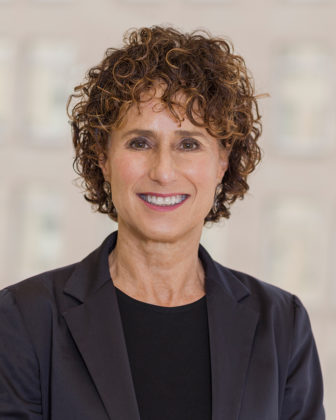
lassedesignen/Shutterstock
.
We have all heard the labels, and sometimes used them ourselves: Foster youth. Special needs kid. Delinquent. Homeless youth.
Such labels are convenient shorthand, but they don’t reflect all that we need to know about the young person in front of us. They generalize what we think we know about youth in similar circumstances while ignoring the young person’s dreams, talents, fears or triumphs. Yes, it takes longer to say “youth involved in juvenile justice and child welfare” instead of using the shorthand of “crossover youth.” But by avoiding these labels we acknowledge that young people are so much more than the one mistake they made or the list of challenges their family is facing.

Susan Notkin
Data can also perpetuate an equally limited understanding of the youth in question. Too often the data we rely on captures only the problems youth face and not their strengths. For example, our field is all too fond of repeating the same unfortunate figures: Among youth who exit foster care, almost a third report being homeless before age 21; over a third are incarcerated by age 17; only 57% have received a high school diploma or GED by age 19; African American and Native American children are disproportionately represented in foster care and juvenile detention.
This is critically important data, and child welfare and juvenile justice systems certainly must have more and better data to drive decisions and reform agendas. But how we present and contextualize the data is equally if not more important. Numbers tell only part of a story. When we look at the graduation rates of youth in foster care or in detention, we view them as very likely a result of moves from placement to placement resulting in missed school days and credit transfers. And we understand that a young person’s unaddressed trauma may have impaired the ability to concentrate in school.
On the other hand, those less knowledgeable or more biased may draw quite a different conclusion. They may wrongly conclude that youth in care must not be as smart as other youth. How we present data determines whether we are ascribing the problems to the individual or the system, and whether it ignores the role that inequalities play in poor outcomes for youth. As a field, we need to avoid what has been called damage imagery and instead provide context to the data we use. We also need to start collecting data that captures youth successes and use it to create conditions that facilitate aspirations in other youth.
When the Center for the Study of Social Policy launched Youth Thrive in 2011, we pursued a new narrative about youth that recognized their individuality and strengths. We sought and presented data and analysis that would place the onus of responsibility where it belongs: on public systems that were failing our young people. We were committed to building a national effort that centered on youth assets and not deficits; that focused as much on building youth protective factors as it did on reducing their risk factors; that worked toward achieving better youth outcomes by highlighting system behavior and functioning; that addressed inequities faced by youth of color and youth who identify as LGBTQ, and, most importantly, that set as our north star the goal of youth thriving in the fullest sense.
That commitment became Youth Thrive.
Healing and thriving, not trauma
Youth Thrive is the name of a research-informed framework that identifies five protective and promotive factors that work to mitigate risk and enhance healthy development and well-being in all youth. Youth Thrive is also the name of CSSP’s national initiative that works in partnership with public and private child welfare, juvenile justice and homeless service agencies to put that research into practice. The effort involves systems re-examining and revising their policies, practices, contracting and training of staff so that they are more aligned with what research indicates youth need to thrive.
The five protective and promotive factors that contribute to healthy adolescent development and well-being are: resilience; social connections; cognitive, social and emotional competencies; knowledge of adolescent development, and concrete supports in times of need. These factors became our goalpost for all youth involved in public systems. We then developed a validated youth self-assessment survey to measure the presence, strength and growth of these important factors in a young person’s life.
But by focusing on enhancing a young person’s protective and promotive factors we faced a challenge: how to make sure we weren’t contributing to the narrative that change needs to happen at the individual and not the system level. Was it only up to youth to strengthen their protective factors or up to workers to change their practice? Certainly young people can and will contribute much to the change process, and it is important that they do, but the primary responsibility rests with the systems themselves and the adults that lead them.
When Youth Thrive began, we were advised by a group of youth with lived experience in foster care who urged us to address healing and thriving instead of focusing primarily on trauma. Part of our approach emphasized the importance of ensuring that all staff who interact with youth be trained in the research that informed Youth Thrive. And we worked with our partner agencies to create opportunities for youth to communicate their dreams, aspirations and talents, drive their case plans and identify the supports they want. These partners have also begun the arduous process of changing contract language, laws, agency policies and practices to be consistent with what the research says youth need to thrive.
The challenge before the field is clear: We need a national commitment to examine and change system policies and practices that thwart a young person’s protective and promotive factors. So besides ensuring that individual youth have supportive social connections, we need to look at policies involving visits with family for youth so that depriving youth of visits with their family members is never used as a punishment and that every effort is made to connect youth with kin. We need to ensure that sibling connections are preserved and that a youth’s first placement is their last placement so we aren’t contributing to broken ties and further trauma.
By federal and state law, agencies are required to be committed to youth well-being. They need to review their data and ask whether they are satisfied with the numbers and timing of youth exiting care, the numbers in congregate care, the numbers on multiple psychotropic medications or who have had numerous placements. And, if not, how can they be helped to change their approach to align the data with their vision of youth thriving?
Workers should understand the basics of adolescent behavior so that their practice reflects that understanding, but workers also need to be supported by agency policy that promotes normalcy and that extends foster care to 21 and beyond.
We all want each youth to learn resilience, but systems need to reconsider how they too often punish youth for mistakes and how they need to more consistently challenge youth to move beyond their comfort zone and try out new experiences, While we need to provide opportunities for youth to advocate for agency policy and programming changes, we also need to invest in organizing youth to change the broader societal conditions that impact their lives because the young people in their care are more than just youth in foster care or on probation: They are New Yorkers and Nebraskans and Americans.
The partner agencies who have embarked on this Youth Thrive journey recognize that the road to improved youth well-being is essential but circuitous. It involves working with youth in different and more compassionate ways and changing policies that support that work. Beyond changing how systems function, it also involves efforts to strengthen families and communities so that youth never have to enter these systems in the first place.
For those of us who work in public child welfare and juvenile justice systems, we must help youth realize dreams so their experience will reflect what we know youth need to thrive.
Susan Notkin is senior vice president at the Center for the Study of Social Policy. She has 40-plus years of experience guiding progressive child welfare and family policy development and innovation at the federal, state and local level.

























